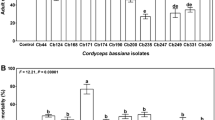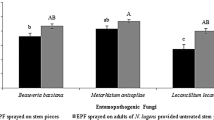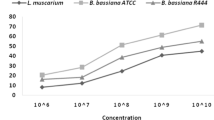Abstract
Microcerotermes diversus Silvestri (Blattodea: Termitidae) is a worldwide destructive termite whose control by conventional methods is often difficult. Biological control using entomopathogenic fungi could be an alternative management strategy. Two species of entomopathogenic fungi, Metarhizium anisopliae and Beauveria bassiana, isolated from natural habitats of Mashhad and Lahijan regions, Iran. The fungi were characterized based on sequences of ITS gene as well as classic data. Then, the infectivity of both isolates of M. anisopliae and B. bassiana in different concentrations (1 × 104, 1 × 105, 1 × 106, 1 × 107, and 1 × 108 conidia/ml) were evaluated under laboratory conditions by two methods, including spray and pipetting against termite, M. diversus. Both entomopathogenic fungi species were capable of infecting and killing M. divesrus. In the pipetting method, the LC50 value for B. bassiana and M. anisopliae calculated 8.03 × 105 (conidia/ml) and 1.03 × 106 (conidia/ml), respectively. But in the spray method, the effect of M. anisopliae on M. diversus was more than B. bassiana. The LC50 value in the spray method for B. bassiana and M. anisopliae was 3.52 × 107 (conidia/ml) and 1.65 × 106 (conidia/ml). The mortality caused by the fungus was dose-dependent, with the highest mortality recorded at the highest concentration. In the pipetting method, the mortality rate for B. bassiana and M. anisopliae was 0 to 97.5% and 0 to 100% at 8 day post infection. In the spray method, the mortality percentage for B. bassiana was from 2.5 to 72.5% and for M. anisopliae was 0 to100% by 4 days post-infection. The results of this study indicated that B. bassiana and M. anisopliae are potentially useful biological control agents for M. diversus. Future studies with field trails will provide a confident approach toward termite management.







Similar content being viewed by others
References
Abbott W (1925) A method of computing the effectiveness of an insecticide. J Econ Entomol 18:265–267
Almeida JEM, Alves SB, Pereira RM (1997) Selection of Beauveria spp. isolates for control of the termite Heterotermes tenuis (Hagen 1858). J Appl Entomol 121:539–543
Arora K, Arora SS (1995) Lindane as termiticide—a review. In: Singh Y (ed) termite management in buildings. Tata McGraw-hill publishing company limited, New Delhi, pp 56–59. Bull Entomol Res 80:309–330
Balachander M, Remadevi OK, Sasidharan TO, Bai S (2009) Infectivity of Metarhizium anisopliae (Deuteromycotina: Hyphomycetes) isolates to the arboreal termite Odontotermes sp. (Isoptera: Termitidae). Int J Trop Insect Sc 29(04):202–207
Burges HD (1981) Strategy for the microbial control of pests in 1980 and beyond. In: Burges HD (ed) Microbial control of pests and plant diseases, 1970–1980. Academic, London, pp 797–836
Cheraghi A, Habbibpour B, Mossadegh MS, Sharififard M (2012) Horizontal transmission of the entomopathogen fungus Metarhizium anisopliae in Microcerotermes diversus groups. Insects 3:709–718. https://doi.org/10.3390/insects3030709
Cheraghi A, Habibpour B, Saied Mossadegh M (2013) Application of bait treated with the entomopathogenic fungus Metarhizium anisopliae (Metsch.) Sorokin for the control of Microcerotermes diversus Silv. Psyche 5 page, https://doi.org/10.1155/2013/865102
Chouvenc T, Su NY, Elliott ML (2008) Interaction between the subterranean termite Reticulitermes flavipes (Isoptera: Rhinotermitidae) and the entomopathogenic fungus Metarhizium anisopliae in foraging arenas. J Econ Entomol 101:885–893
Culliney TW, Grace JK (2000) Prospects for the biological control of subterranean termites (Isoptera: Rhinotermitidae), with special reference to Coptotermes formosanus. B Entomol Res 90:9–21
Darsouei R, Karimi J, Ghadamyari M, Hosseini M (2018) Diverse natural enemies of the sugar beet army worm, Spodoptera exigua in north east of Iran. Entomol News 127(5):446–464
Dong C, Zhang J, Huang H, Chen W, Hu Y (2009) Pathogenicity of new China variety of Metarhizium anisopliae (Manisopliae var. dcjhyium) to subterranean termite Odontotermes formosanus. Microbiol Res 164:27–35
Eilenberg J, Hajek A, Lomer C (2001) Suggestions for unifying the terminology in biological control. Biocontrol 46:387–400
Felsenstein J (1985) Confidence intervals on phylogenies: an approach using the bootstrap. Evolution 39:783–791
Fernandes PM (1991) Controle microbiano de Cornitermes cumulans (Kollar, 1832) Utilizando Beauveria bassiana (Bals) Vuill and Metarhizium anisopliae (metsch) Sorok. PhD dissertation, ESALQ-Universidade de Sao Paulo, Piracicaba, Brazil
Ghayourfar R (2005) Three new species of termites from Iran. Zool Middle East 34:61–66
Ghayourfar R, Mohammadpour K (2009) An investigation on the subterranean termite control in date palm orchard of Saravan region using baiting system. App Entomol Phytopath 87:1–17
Grace JK (1993) Microbial termite control: effect of entomogenous fungi on the Formosan subterranean termite (Isoptera: Rhinotermitidae). In:Wildey KB, Robinson WH (eds) Proceedings of 1st international conference on insect pest in the urban environment, St John’s College, Cambridge, 30 June–3 July 1993, Organizing committee of the international conference on insect pests in the urban environment, Exeter, pp 474
Grace JK, Zoberi MH (1992) Experimental evidence for transmission of Beauveria bassiana by Reticuliitermes flavipes workers (Isoptera: Rhinotermitidae). Sociobiology 20:23–28
Habibpour B (1994) Termites (Isoptera) fauna, economic importance and their biology in Khuzestan, (Iran). M.S. thesis, College of Agriculture, Shahid-Chamran University of Ahvaz, Iran. 120 pp
Habibpour B (2006) Laboratory and field evaluation of bait-toxicants for suppression subterranean termite populations in Ahvaz (Iran) [Ph.D. thesis], Department of Plant Protection, College of Agriculture, Shahid Chamran University of Ahvaz, Khuzestan
Hamill RL, Higgins CE, Boaz HE, Gorman M (1969) The structure of beauvericin, a new depsipeptide antibiotic toxic to Artemia salina. Tetrahedron Lett (49):4255–5258
Jones WE, Grace JK, Tamashiro M (1996) Virulence of seven isolates of Beauveria bassiana and Metarhizium anisopliae to Coptotermes formosanus (Isoptera: Rhinotermitidae). Environ Entomol 25:481–487
Karimi J, Darsouei R (2014) Presence of the endosymbiont Wolbachia among some fruit flies (dip., Tephritidae) from Iran and its evolutionary history. J Asia Pac Entomol 17:105–112
Kimura M (1980) A simple method for estimating evolutionary rates of base substitutions through comparative studies of nucleotide sequences. J Mol Evol 16(2):111–120
Kramm KR, West DF, Rockenbach PG (1982) Termite pathogens: transfer of the entomopathogen Metarhizium anisopliae between Reticulitermes species termites. J Invertebr Pathol 40:1–6
Kramm KR, West DF, Rokenback PG (1992) Termite pathogens trasfer of the entomopathogen Metarhizium anisopliae between Reticulitermitidae. J Invertebr Pathol 39:1–5
Kumar S, Stecher G, Tamura K (2016) MEGA7: molecular evolutionary genetics analysis version 7.0 for bigger datasets. Mol Biol Evol 33(7):1870–1874. https://doi.org/10.1093/molbev/msw054
Lacey LA, Kaya HK (2000) Eds. Springer: London, UK, 2000; pp. 153–177
Lai PY, Tamashiro M, Fujii JK (1982) Pathogenicity of six strains of entomogenous fungi to Coptotermes formosanus. J Invertebr Pathol 39:1–5
Larkin MA, Blackshields G, Brown NP, Chenna R, McGettigan PA, McWilliam H, Valentin F, Wallace IM, Wilm A, Lopez R, Thompson JD, Gibson TJ, Higgins DG (2007) Clustal W and Clustal X version 2.0. Bioinformatics 23:2947–2948
Logan JWM, Cowie RH, Wood TG (1990) Termite (Isoptera) control in agriculture and forestry by non-chemical methods: a review. Bull Entomol Res 80:309–330
Milner RJ (2000) Improved formulation of Metarhizium for biological control of termites CSIRO division of termites. Entomol Tech Rep 86:37
Milner RJ, Staples JA (1996) Biological control of termites: results and experiences within a CSIRO project in Australia. Biocontrol Sci Tech 6:3–9
Milner RJ, Staples JA, Lutton GG (1998) The selection of an isolate of the hyphomycete fungus, Metarhizium anisopliae, for the control of termites in Australia. Biol Control 11:240–247
Neves PJ, Alves SB (2000) Selection of Beauveria bassiana (Bals.) Vuill. and Metarhizium anisopliae (Metsch.) Sorok strains for control of Cornitermes cumulans (Kollar). Braz Arch Biol Technol 43:373–378
Pais M, Das BC, Ferron P (1981) Depspeptides from Metarhizium anisopliae. Phytochemistry 20:715–723
Pell JK, Eilenberg J, Hajek AE, Steinkraus DC (2001) In: butt, T.M., Jackson, C., Magan, N. (Eds.), Fungi as biocontrol agents: Progress, problems and potential. CAB International, Wallingford, pp 71–153
Pik-Kheng H, Choon-Fah J, Bong KJ, Amartalingam R (2009) Evaluation of Metarhizium anisopliae var. anisopliae (Deuteromycotina: Hyphomycete) isolates and their effects on subterranean termite Coptotermes curvignathus (Isoptera: Rhinotermitidae). Am J Agric Biol Sci 4(4):289–297
Rahimzadeh AR, Rashid M, Sheikhi Garjan A, Naseri B (2012) Laboratory evaluation of Metarhizium anisopliae (Metschnikoff) for controlling Amitermes vilis (Hagen) and Microcerotermes gabrielis (Weidner) (Isoptera: Termitidae). J Crop Prot 1(1):27–34
Ramakrishnan R, Suiter DR, Nakatsu CH, Humber RA, Bennett GW (1999) Imidacloprid-enhanced Reticulitermes lavipes (Isoptera: Rhinotermitidae) susceptibility to the entomopathogen Metarhizium anisopliae. J Econ Entomol 92(5):1125–1132
Rath AC (2000) The use of entomopathogenic fungi for control of termites. Biocontrol Sci Tech 10:563–581
Ravindran K, Qiu D, Sivaramakrishnan S (2015) Sporulation characteristics and virulence of Metarhizium anisopliae against subterranean termites (Coptotermes formosanus). Int J Microbiol Res 6(1):1–4
Saitou N, Nei M (1987) The neighbor-joining method: a new method for reconstructing phylogenetic trees. Mol Biol Evol 4:406–425
Sajap AS, Kaur K (1990) Histopathology of Metarhizium anisopliae, an entomopathogenic fungus, infection in the termite, Coptotermes curvignathus. Pertanika 13:331–334
SAS Institute (1989) SAS/STAT user's guide, release 6.03. SAS Institute, Cary
Simon C, Frati F, Beckenbach A, Crespi B, Liu H, Flook P (1994) Evolution, weighting, and phylogenetic utility of mitochondrial gene sequences and a compilation of conserved polymerase chain reaction "primers". Ann Entomol Soc Am 87:651–701
Singha D, Singha B, Dutta BK (2011) Potential of Metarhizium anisopliae and Beauveria bassiana in the control of tea termite Microtermes obesi Holmgren in vitro and under field conditions. J Pest Sci 84:69–75
Toumanoff C, Rombaut J (1965) Action de divers champignons entomophage cultives sur les milieu appropries attractifs, sur le termite de Saintonge Reticulitermes santonensis. Annales de Parasitologie 40:605–609
Vargo EL, Husseneder C, Grace JK (2003) Colony and population genetic structure of the Formosan subterranean termite, Coptotermes fomosanus, in Japan. Mol Ecol 12(10):2599–2608
Vega FE, Dowd PF, Lacey LA, Pell JK, Jackson DM, Klein MG (2000) Dissemination of beneficial microbial agents by insects. In: Lacey LA, Kaya HK (eds) Field manual of techniques in invertebrate pathology. Kluwer, London, pp 153–177
Wells JD, Fuxa JR, Henderson G (1995) Virulence of four fungal pathogens to Coptotermes formosanus (Isoptera: Rhinotermitidae). J Entomol Sci 30:208–215
White TJ, Bruns T, Lee S, Taylor J (1990) Amplification and direct sequencing of fungal ribosomal RNA genes for phylogenetics. In: Innis MA, Gelfand DH, Sninsky JJ, White TJ (eds) PCR protocols: a guide to methods and applications. Academic Press, New York, pp 315–322
Wright SW, Raina AK, Lax AR (2005) Strain of the fungus Metarhizium anisopliae for controlling subterranean termites. J Econ Entomol 98(5):1451–1458
Yanagawa A, Shimizu S (2005) Defense strategy of the termite, Coptotermes foumosanus Shiraki to entomopathogenic fungi. JpnJ Environ Entomol Zool 16:17–22
Yanagawa A, Shimizu S (2007) Resistance of the termite, Coptotermes formosanus Shiraki to Metarhizium anisopliae due to grooming. BioControl 52:75–85
Zoberi MH (1995) Metarhizium anisopliae, a fungal pathogen of Reticultermes flavipes (Isoptera: Rhinotermitidae). Mycologia 87:354–359
Zoberi MH, Grace JK (1990) Isolation of the pathogen Beauveria bassiana from Reticulitermes flavipes (Isoptera: Rhinotermitidae). Sociobiology 16:289–296
Acknowledgements
The authors appreciate from Ferdowsi University of Mashhad (FUM) for financial support of MSc thesis of first author under supervision of JK (P3/48588).
Author information
Authors and Affiliations
Corresponding author
Ethics declarations
Conflict of interest
The authors confirm they don’t have any conflict of interest.
Additional information
Publisher’s note
Springer Nature remains neutral with regard to jurisdictional claims in published maps and institutional affiliations.
Rights and permissions
About this article
Cite this article
Al-Farhani, H., Darsouei, R., Kamali, S. et al. Pathogenicity of native isolates of entomopathogenic fungi Beauveria and Metharizium genera on Microcerotermes diversus (Blattodea: Termitidae) in the laboratory. Int J Trop Insect Sci 41, 1493–1503 (2021). https://doi.org/10.1007/s42690-020-00347-w
Received:
Revised:
Accepted:
Published:
Issue Date:
DOI: https://doi.org/10.1007/s42690-020-00347-w




